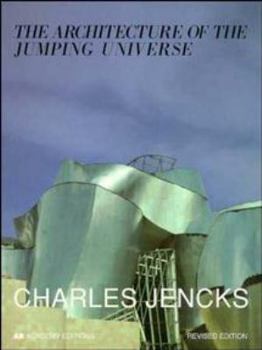The Architecture of the Jumping Universe: A Polemic: How Complexity Science Is Changing Architecture and Culture
Charles Jencks has the uncanny capacity to announce a new movement in architecture before it has begun. With Post-Modernism, he was looking to the past. Now, for the first time, with his new book on morphogenesis he is taking a look at the future. There is no question that his argument will have an important critical effect on architecture at the beginning of the new millennium. Peter Eisenman. Architect A new paradigm is sweeping through science, changing both our view of the universe and of mankind. Charles Jencks is one of a handful of thinkers with the courage to embrace the emerging paradigm and interpret it architecturally. This inspired synthesis of art, design, science and philosophy charts a bold new course not only for architecture, but for Post-Modern thought. Paul Davies, Professor of Natural Philosophy, University of Adelaide, author of The Cosmic Blueprint, Superforce, The Mind of God and other books on contemporary science. Who else could have written a book that opens up such cosmic perspectives and still make such neat, sharply focused comments on particular architects and particular styles of architecture? Who else could range with such zest, ease and elegance from Chaos to Bruce Goff, from Coleridge to Frank Gehry, from Complexity Theory to Green Buildings? The old question of in which style should we build can never be addressed in the same way again. Charles Jencks has brought purpose back into architecture. His teleology may transcend what architects are used to, but Jencks manages to make far more sense out of our contemporary architectural dilemmas than practically all the other books in the RIBA book shop. Francis Duffy, Chairman of DEGW International Ltd
Format:Paperback
Language:English
ISBN:0471977489
ISBN13:9780471977483
Release Date:May 1997
Publisher:Academy Press
Length:192 Pages
Weight:1.60 lbs.
Dimensions:0.7" x 7.6" x 9.9"
Customer Reviews
1 rating
This will be viewed as an important book in the 21st century
Published by Thriftbooks.com User , 26 years ago
In the coming century, this book will be known as ground breaking. In our culture, architects do not have the ability to look forward and see changing paradigms. This book successfuly outlines an emerging design paradigm for the 20th century. Unfortnately it dwells too much in style and not enough in substance when examples are used. The issue of green architecture and ecology which i belive are the heart of architecture's relationship to complexity theory are given very short chapters. Instead, Jencks focuses on stylistic expressions of chaos from the likes of Gehry and Eisenmann. Overall though, this is a book that every young, impressionable architect should read right away!





